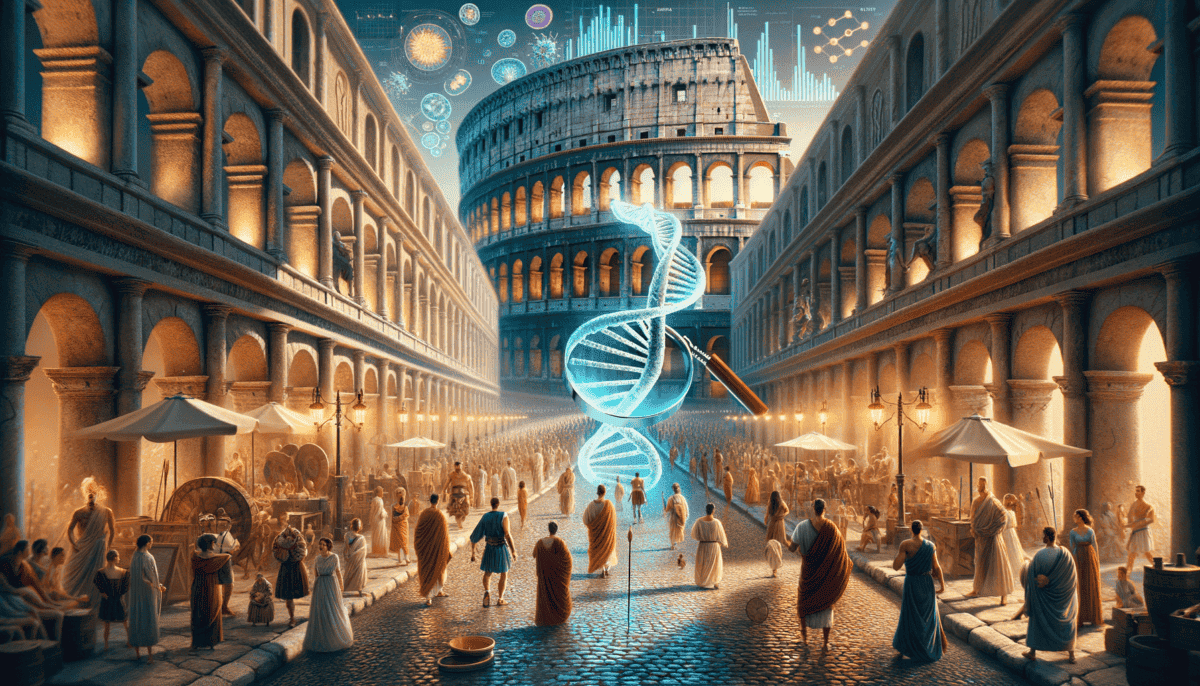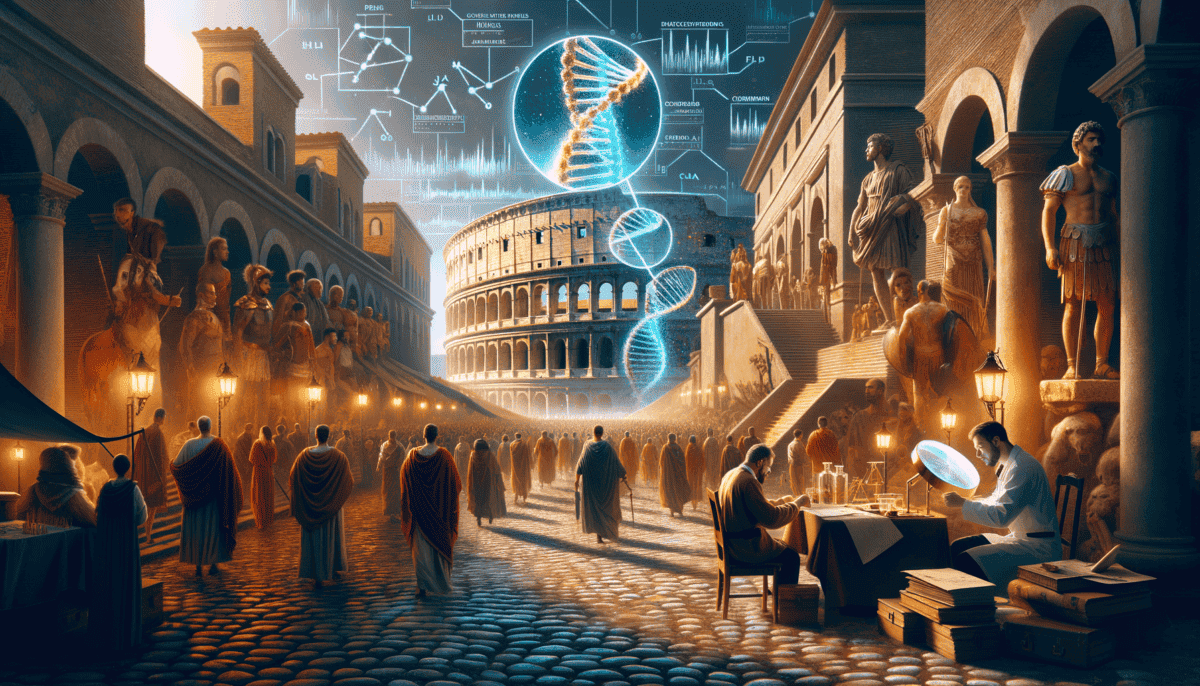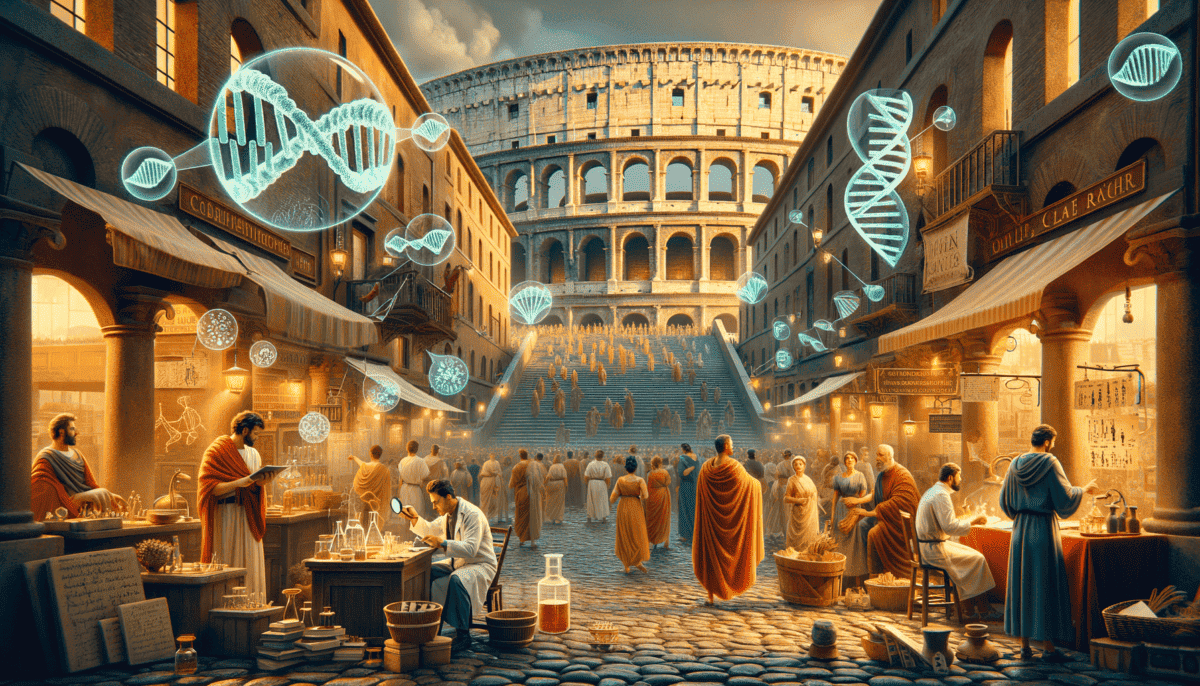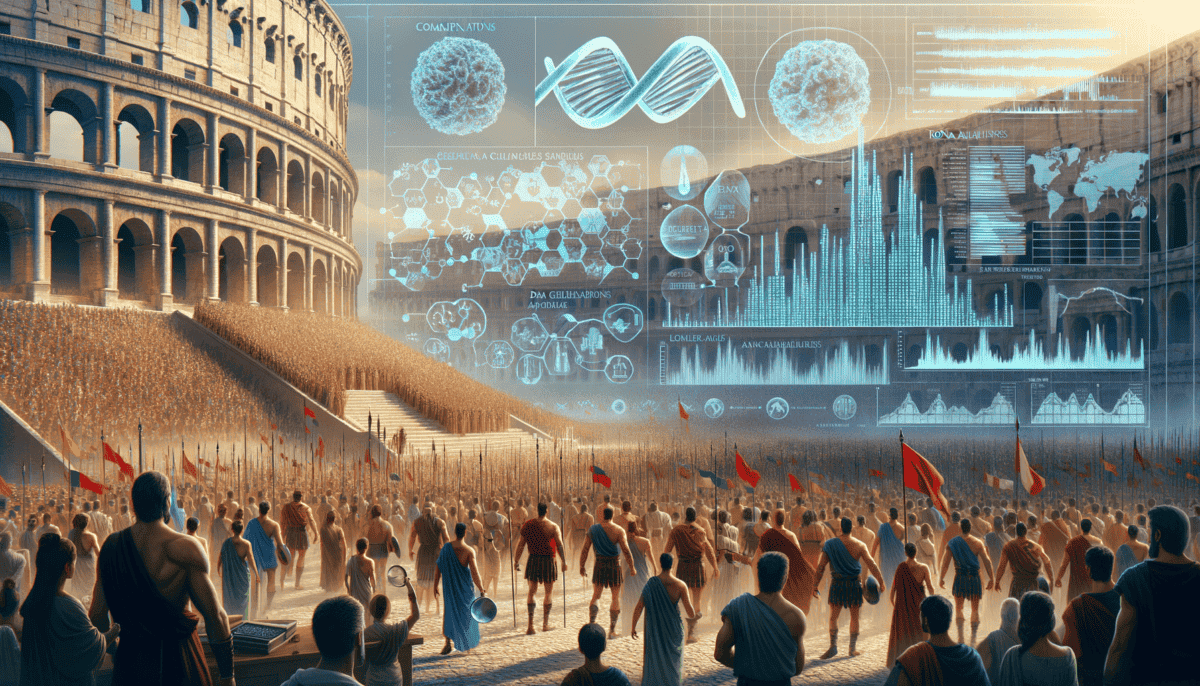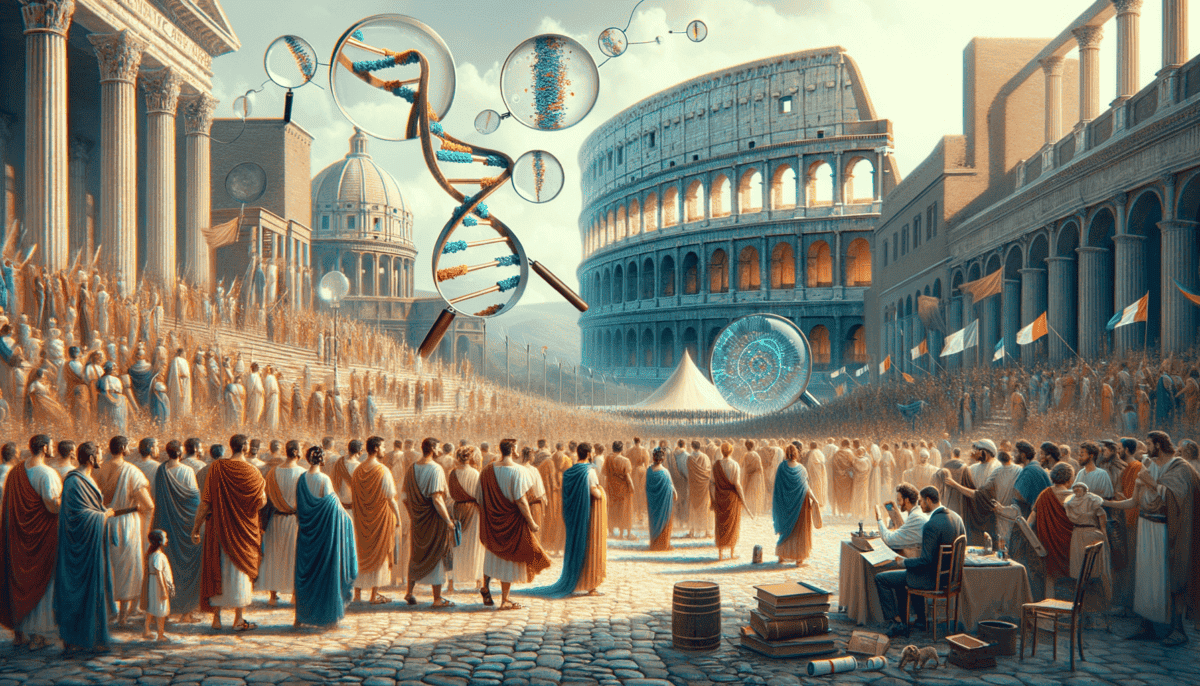The Genetic Time Machine
Dr. Sarah Chen stared at her computer screen with wide eyes. The lab was quiet except for the soft hum of machines. "I can't believe what I'm seeing!" she whispered.
Her colleague, Dr. Marcus Rodriguez, rushed over. "What did you find, Sarah?"
"Look at these DNA results from the ancient Roman bones. They tell us something amazing about the people who lived in Rome long ago!"
Sarah and Marcus were part of a special team called the DNA Detectives. They used tiny pieces of old bones to learn about people who lived 2,000 years ago in Rome. It was like having a time machine made of science!
"The DNA shows that Rome was full of people from all over the world," Sarah explained. "Some came from far away places like Africa, the Middle East, and even Britain!"
Marcus nodded excitedly. "It's like ancient Rome was a big mixing bowl of different people, just like our cities today!"
The First Big Discovery
The team worked in a special lab with shiny equipment and bright lights. They had to be very careful with the old bones. Each one was like a precious treasure that could tell them stories about the past.
"Remember how we thought most Romans looked the same?" Sarah asked. "Well, we were wrong! The DNA shows they had different colored hair, eyes, and skin – just like people today!"
Dr. Elena Santos, another team member, joined them. She was carrying a map covered in colorful lines. "Look at this! These lines show how people moved around the Roman Empire. It's like following their footsteps through time!"
The three scientists gathered around the map, their eyes sparkling with excitement. Each line told a story of people traveling across land and sea to make Rome their home.
Solving Ancient Puzzles
Working with ancient DNA wasn't easy. Sometimes the bones were too old and broken to tell them much. But when they found good DNA, it was like finding buried treasure!
"It's like putting together a giant puzzle," Elena said. "Each piece of DNA helps us see the bigger picture of life in ancient Rome."
The team worked late into the night. They were too excited to go home. Their computers showed more and more amazing things about the Romans.
| What They Knew Before | What DNA Showed |
|---|---|
| Romans all looked similar | Romans looked very different from each other |
| People didn’t travel much | People came from all over the world |
Sarah stretched and smiled at her friends. "Just think – we're the first people to know these secrets about ancient Rome. What else will we find tomorrow?"
The lab grew quiet again, but the excitement stayed in the air. The DNA Detectives knew they were just beginning their amazing journey into the past. Tomorrow would bring new discoveries and more amazing stories about the people who lived in ancient Rome.
Royal Secrets in Ancient Bones
Dr. Sarah Chen walked into the lab early the next morning. Today was special! Her team would look at DNA from Roman noble families.
“Marcus! Elena! Come see this!” Sarah called to her friends. She pointed to her computer screen. “This DNA comes from a rich Roman family’s tomb!”
Surprising Family Trees
Marcus looked closely at the DNA results. His eyes got big. “Wait… this noble family wasn’t all from Rome! Some of their DNA shows they came from Egypt!”
“And look here,” Elena added, pointing to another part of the screen. “This person who lived in a big fancy house has DNA like the people who worked in the streets!”
The team was learning that Roman nobles weren’t as different from other Romans as everyone thought. Rich people and poor people often had the same great-great-grandparents!
| What People Thought | What DNA Showed |
|---|---|
| Noble families only married other noble families | Noble families had relatives from all parts of society |
| Rich Romans were very different from poor Romans | Rich and poor Romans often shared the same ancestors |
Health Secrets from the Past
“Look what else the DNA tells us,” Sarah said. “We can see what made some Romans sick and what kept others healthy!”
The team found that some Roman families had special DNA that helped them fight off diseases. Others had DNA that made them more likely to get sick.
Detective Work Gets Hard
Working with such old DNA wasn’t easy. Sometimes it was like trying to read a book that got wet and fell apart.
“This DNA sample is too broken,” Elena sighed, looking at a new test result. “It’s like trying to put together a puzzle when most pieces are missing!”
But the team didn’t give up. They knew each piece of DNA they could read was important. It helped them understand how people lived in ancient Rome.
Big Surprises
“You won’t believe this!” Marcus called out later that day. “This DNA shows that one of Rome’s most famous leaders had family from Greece!”
Sarah smiled. “And here’s someone from a poor family who had royal Egyptian ancestors. Ancient Rome was full of surprises!”
The lab buzzed with excitement. Each new discovery showed that ancient Roman society was more mixed than anyone had imagined. Rich or poor, noble or common – everyone’s family story was special and surprising.
As the sun set outside their lab, the DNA Detectives saved their work and got ready to go home. Tomorrow they would look at DNA from Roman soldiers. What new secrets would they find?
Warriors from Many Lands
The morning sun lit up the lab as Sarah, Marcus, and Elena gathered around their newest samples. These bones came from old Roman army camps! ⚔️
“These soldiers fought for Rome all over the world,” Sarah said, holding up a small bone fragment. “Let’s see where they really came from!”
A World in One Army
“This is amazing!” Elena exclaimed, looking at her computer screen. “This soldier who died in Britain had DNA from Syria!”
Marcus nodded excitedly. “And look here – these three soldiers who fought together came from Spain, Germany, and North Africa!”
| Where They Fought | Where They Came From |
|---|---|
| Britain | Syria, Spain, Italy |
| Egypt | Germany, Greece, Africa |
New Homes, New Families
“Something interesting is happening here,” Sarah pointed out. “Many soldiers stayed in the places where they fought. They married local people and had families!”
The DNA showed how soldiers changed the places they went. When they married local people, their children had mixed DNA. This made each place’s people more diverse!
Stories in the Bones
“Look at this soldier’s DNA,” Elena said softly. “He fought in many battles. His bones show he was strong and brave.”
“And here’s something sad,” Marcus added. “This young soldier died far from home. His DNA shows his family was from Greece, but he died in France.”
Each bone told a story of someone who left home to fight for Rome. Some were scared, some were brave, but all helped change the world. ️
Big Changes
The team found that Roman armies changed Europe’s DNA forever. Wherever soldiers went, they mixed with local people. Their children had DNA from both parents.
“It’s like stirring different colors of paint,” Sarah explained. “The soldiers helped mix people from all over the world!”
As the day ended, Sarah looked at all their findings. “The Roman army wasn’t just about fighting,” she said. “It was about bringing different people together.”
The team carefully packed away their samples. Tomorrow they would study how ancient Romans dealt with diseases. What would the DNA tell them about staying healthy in ancient times?
When Sickness Struck Rome
Sarah rushed into the lab early one morning, her eyes sparkling with excitement. “Everyone, look what we found in these bones! Signs of an ancient plague!”
“What kind of plague?” Marcus asked, leaning closer to the microscope.
Super Survivors
Elena typed quickly on her computer. “These bones tell us something special. Some Romans had DNA that made them stronger against sickness!”
“It’s like having a super shield in your body,” Sarah explained with a smile. “Just like we have medicine today, some Romans had natural protection in their blood.”
| Time Period | Disease Protection |
|---|---|
| Early Rome | Less Protection |
| After Plagues | More Protection |
City Life Changes
“Living in big cities made Romans adapt,” Marcus said. “Their DNA changed to help them stay healthy when lots of people lived close together.”
The team found that Romans who survived big sicknesses passed their strong DNA to their children. These children were better at fighting off diseases!
Healing Secrets
“Look at these teeth marks,” Elena pointed out. “They show this person ate special plants to stay healthy.”
Sarah picked up a small jar. “And this old medicine pot still has traces of healing herbs. The Romans were smart about staying healthy!”
Tough Times, Stronger People
“Each big sickness made the Romans stronger,” Marcus explained. “The people who lived through them had special DNA that helped them survive.”
“It’s like each time they got sick, their bodies learned new tricks to stay healthy,” Sarah added.
The team worked late into the evening, amazed by how the Romans fought off diseases. They learned that some modern medicines work the same way ancient Romans’ bodies did!
“Tomorrow we’ll look at how Rome changed when new people came to live there,” Elena said, carefully storing their samples. What new secrets would they find in the DNA of Rome’s final days?
“The Romans didn’t just build strong buildings – they built strong bodies too!” – Sarah’s research notes
When Rome’s World Changed
Marcus stared at the computer screen, his eyes wide with wonder. “Look at this! The DNA from late Roman times is so different!”
“You’re right,” Elena said, pointing to the colorful patterns on the screen. “It’s like watching Rome’s big family tree grow new branches.”
New Neighbors
Sarah spread out a big map on the table. “See these arrows? They show where new people came to Rome. They brought their own DNA with them!” ️
“It’s like adding new colors to a painting,” Marcus explained to the team. “Each new group made Rome’s DNA picture more colorful.”
| Time | DNA Changes |
|---|---|
| Early Rome | Mostly Local DNA |
| Late Rome | Mix of Many DNAs |
Finding New Friends
“Look at these bones,” Elena said excitedly. “This person’s mom came from far away, but their dad was from Rome!”
The team found many stories like this. People from different places made new families together in Rome. Their children had special DNA that showed both where mom and dad came from.
Changing Times
“Rome didn’t end quickly,” Sarah explained. “It changed slowly, like how seasons change from summer to fall.”
Marcus nodded. “The DNA shows us that new people didn’t just take over. They became part of Rome’s big family.”
Special Clues
Elena held up a tiny bone fragment. “This tells us something amazing. Even when Rome wasn’t as strong, its people were still trading and traveling!”
“Each piece of DNA is like a letter from the past, telling us how Rome’s big family grew and changed.” – Elena’s notebook
The team worked carefully with their special tools. They found that some Roman families still live in Italy today! Their DNA tells a story that goes back thousands of years. ⏳
“Tomorrow we’ll see how Roman DNA still lives in people today,” Sarah said, carefully putting away their samples. What secrets would they find about how ancient Romans are connected to people now?
Connecting Past and Present
The morning sun streamed through the laboratory windows as Sarah picked up the last DNA sample. “Friends, we’re about to make the biggest discovery yet!”
“What did you find?” Marcus leaned forward eagerly.
Sarah pointed to her computer screen. “Look at this modern DNA from people living in Rome today. It matches some of our ancient samples!”
Finding Family
Elena pulled up a map showing tiny dots all over Europe. “Each dot shows someone today who has Roman DNA. It’s like a giant family tree!”
“Some people in England, Spain, and even Greece have Roman ancestors,” Marcus explained. “The Romans left their DNA like tiny presents all over Europe!”
| Place | Roman DNA Found |
|---|---|
| Italy | Very Common |
| Other Countries | Sometimes Found |
Special Stories
“Watch this!” Sarah typed on her computer. A family tree appeared, connecting an ancient Roman soldier to a little girl living in Rome today.
“DNA is like a time machine. It lets us shake hands with our great-great-great-grandparents!” – Marcus
New Ways to Learn History
Elena held up her notebook. “Our DNA detective work shows that history books don’t tell the whole story. The Romans were like a big rainbow of different people!”
Looking Forward
“This is just the beginning,” Sarah said, carefully storing their samples. “There are so many more DNA secrets waiting to be found!” ⭐
Marcus smiled. “Maybe some kids reading this will become DNA detectives too. They might solve even bigger mysteries!”
The Greatest Discovery
The team gathered around their final display. Pictures showed Roman faces next to modern ones, connected by swirling lines of DNA.
As the sun set on their last day of research, Elena wrote in her diary: “The Romans never really went away. They’re still here, in the DNA of people all around us. Every time we look at our DNA results, we’re reading a story that’s been waiting thousands of years to be told.” ✨
The DNA detectives had solved their biggest mystery. But they knew this wasn’t the end – it was just the beginning of many more amazing discoveries waiting to be made about our ancient family tree!


